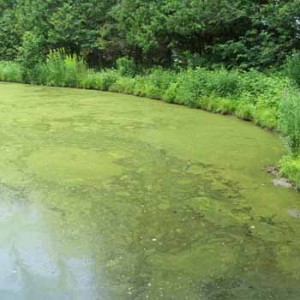Visible cyanobacteria blooms? Important precautions for you and your family
Blue-green algae (cyanobacteria) are aquatic microorganisms that can generally be found in all bodies of water in Québec. They multiply mainly in the summer in water that contains significant amounts of nutrients, particularly phosphorus. A mass of cyanobacteria in a body of water forms what is called an algal bloom or even a scum on all or part of the surface. When that happens, the water can look like green paint or broccoli or pea soup.
Consult the PDF original document on the Government of Quebec (in French)
 Health impact of blue-green algal bloom
Health impact of blue-green algal bloom
Certain blue-green algae release toxins that can cause health issues, although they are usually minor. For example, direct contact with a blue-green–algae bloom when swimming or boating can result in skin, nose, throat, or eye irritation.
In addition, swallowing water containing blue-green algae can also produce minor symptoms, which are generally gastrointestinal in nature (diarrhea, nausea, vomiting). Ingesting significant quantities of toxin can, however, have more serious effects on the liver and nervous system. While there have been no such occurrences in humans in Québec or Canada, some animal deaths from ingesting toxins have been reported.
Risk to young children
Young children are at greater risk of health problems. Indeed, blue-green algae and their toxins tend to accumulate along the edges of affected bodies of water, which is where children tend to play. As a result, children are more likely to accidentally ingest water when swimming or boating.
General recommendations for drinking water
If your drinking water comes directly from a body of water:
Water should never be drunk from a lake, river, or stream without treating it. If you notice a blue-green–algae bloom near your water intake and your water system doesn’t have an effective device for treating (available in French only) against blue-green algae and its toxins, you should avoid using your water for:
- Drinking
- Preparing beverages or ice cubes
- Preparing or cooking food
Boiling the water will not eliminate the toxins.
The water can be used for personal hygiene, laundry, and other basic household uses unless it has an unusual color or odor. If your drinking water comes from a well or a public water system
Unless indicated otherwise, you may continue to use your water normally. For more information, please refer to the list of drinking-water notices.
General recommendations for swimming and other water and boating activities
A body of water can be partially or completely affected by blue-green–algae blooms. The list of beaches that have been completely closed can be found on the MDDEP Web site.
Affected areas (obvious color)
Avoid water and boating activities that involve prolonged exposure with the blooms, such as:
- Swimming
- Water-skiing
- Windsurfing
- Diving
- Kayaking
You can resume your water and boating activities 24 hours after algae blooms have disappeared from recently affected areas.
Unaffected areas
You can swim and engage in water and boating activities as usual.
Additional recommendations
As a precaution, you should avoid eating the viscera (guts) of fish caught in bodies of water with significant algae blooms. You should also prevent your pets or animals from drinking from or swimming in algae blooms or scum, or anywhere in their vicinity. If you think that an animal has died as the result of exposure to blue-green algae, call Services Québec at 1-877-644-4545.
Source: Santé et Services sociaux du Québec